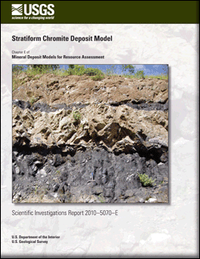Stratiform chromite deposit model
Links
- More information: USGS Index Page
- Document: Report Low Resolution (15 MB pdf)
- Download citation as: RIS | Dublin Core
Abstract
A new descriptive stratiform chromite deposit model was prepared which will provide a framework for understanding the characteristics of stratiform chromite deposits worldwide. Previous stratiform chromite deposit models developed by the U.S. Geological Survey (USGS) have been referred to as Bushveld chromium, because the Bushveld Complex in South Africa is the only stratified, mafic-ultramafic intrusion presently mined for chromite and is the most intensely researched. As part of the on-going effort by the USGS Mineral Resources Program to update existing deposit models for the upcoming national mineral resource assessment, this revised stratiform chromite deposit model includes new data on the geological, mineralogical, geophysical, and geochemical attributes of stratiform chromite deposits worldwide. This model will be a valuable tool in future chromite resource and environmental assessments and supplement previously published models used for mineral resource evaluation.
Stratiform chromite deposits are found throughout the world, but the chromitite seams of the Bushveld Complex, South Africa, are the largest and most intensely researched. The chromite ore is located primarily in massive chromitite seams and, less abundantly, in disseminated chromite-bearing layers, both of which occur in the ultramafic section of large, layered mafic-ultramafic stratiform complexes. These mafic-ultramafic intrusions mainly formed in stable cratonic settings or during rift-related events during the Archean or early Proterozoic, although exceptions exist. The chromitite seams are cyclic in nature as well as laterally contiguous throughout the entire intrusion. Gangue minerals include olivine, pyroxenes (orthopyroxene and clinopyroxene), plagioclase, sulfides (pyrite, chalcopyrite, pyrrhotite, pentlandite, bornite), platinum group metals (mainly laurite, cooperite, braggite), and alteration minerals. A few deposits also contain rutile and ilmenite. The alteration phases include serpentine, chlorite, talc, magnetite, kaemmererite, uvarovite, hornblende, and carbonate minerals, such as calcite and dolomite.
Stratiform chromite deposits are primarily hosted by peridotites, harzburgites, dunites, pyroxenites, troctolites, and anorthosites. Although metamorphism may have altered the ultramafic regions of layered intrusions postdeposition, only igneous processes are responsible for formation. From a diagnostic standpoint and for assessment purposes, they have no temporal or spatial relation to sedimentary rocks.
The exact mechanisms responsible for the development of stratiform chromite deposits and the large, layered mafic-ultramafic intrusions where they are found are highly debated. The leading argument postulates that a parent magma mixed with a more primitive magma during magma chamber recharge. The partially differentiated magma could then be forced into the chromite stability field, resulting in the massive chromitite layers found in stratiform complexes. Contamination of the parent magma by localized assimilation of felsic country rock at the roof of the magma chamber has also been proposed as a mechanism of formation. Others suggest that changes in pressure or oxygen fugacity may be responsible for the occurrence of massive chromitite seams in layered mafic, ultramafic intrusions.
The massive chromitite layers contain high levels of chromium and strong associations with platinum group elements. Anomalously high magnesium concentrations as well as low sodium, potassium, and phosphorus concentrations are also important geochemical features of stratiform chromite deposits. The presence of orthopyroxenite in many of the deposits suggests high silica and high magnesium concentrations in the parent magma.
Most environmental concerns associated with the mining and processing of chromite ore focus on the solubility of chromium and its oxidation state. Although trivalent chromium (Cr3+) is an essential micronutrient for humans, hexavalent chromium (Cr6+) is highly toxic. Chromium-bearing solid phases that occur in the chromite ore-processing residue, for example, can effect the geochemical behavior and oxidation state of chromium in the environment.
| Publication type | Report |
|---|---|
| Publication Subtype | USGS Numbered Series |
| Title | Stratiform chromite deposit model |
| Series title | Scientific Investigations Report |
| Series number | 2010-5070 |
| Chapter | E |
| DOI | 10.3133/sir20105070E |
| Year Published | 2012 |
| Language | English |
| Publisher | U.S. Geological Survey |
| Publisher location | Reston, VA |
| Contributing office(s) | Central Mineral and Environmental Resources Science Center, Eastern Mineral and Environmental Resources Science Center |
| Description | xiv, 131 p. |
| Larger Work Type | Report |
| Larger Work Subtype | USGS Numbered Series |
| Larger Work Title | Mineral deposit models for resource assessment (Scientific Investigations Report 2010-5070) |
| Online Only (Y/N) | Y |
| Additional Online Files (Y/N) | Y |


